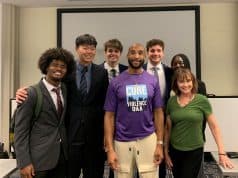Get Goizueta‘s top tips for advancing digital fluency for both individuals and organizations from Professor Anandhi Bharadwaj and Emory Executive Education.
In today’s data-driven business climate, employees need to understand how to leverage technology more than ever. Digitally fluent teams contribute proficiency in a variety of technology tools that make companies more innovative, collaborative, and competitive.
Emory Executive Education helps senior leadership teams of Fortune 100 companies reimagine how to increase digital fluency among their employees.
The digital landscape today is rapidly evolving,” says Anandhi Bharadwaj, professor of information systems and operations management and Goizueta endowed chair in electronic commerce. “It’s crucial for organizations to advance digital fluency to stay competitive and.”
“Many of the companies we work with are 50 to 100 or more years old. Making a plan to advance digital fluency helps them think through how to compete and how to transform and reimagine themselves. It also helps them see opportunities in a new light.”
Bharadwaj says any digital fluency program must be endorsed at the top to be successful.
“Leaders should lead by example. They have to actively participate in digital initiatives and model the behavior they expect,” she says. “This sets a tone for the importance of digital fluency at all levels of the organization.”
Tips for Advancing Digital Fluency
Top Tips for Companies
Many of the elements of a program they created for one of their Fortune 100 clients are built around five capabilities. Bharadwaj says these capabilities will benefit companies of any size and in any industry.
- Digital-First: Foster a company culture that embraces digital innovation and transformation. This includes encouraging a mindset shift among employees to think and operate in a digitally forward manner.
- Continuous Learning: Develop a culture of ongoing learning by offering courses, workshops and training sessions on new technologies and digital trends. This helps employees stay up-to-date with the latest advances.
- Fail-Fast Innovation and Curiosity: Create an environment where it’s safe to experiment with new technologies. A fail-fast approach allows employees to follow their curiosity, learn from mistakes, and innovate without fear.
- Cross-Functional Collaboration: Collaboration between departments with different ideas, skills, and digital expertise can lead to a more digitally fluent workforce.
- Digital Goals in Business Strategy: Make digital fluency a core component of your business strategy. This includes setting specific digital objectives and key performance indicators.
Companies also should regularly assess the level of digital fluency their employees have, Bharadwaj adds. “Solicit feedback to understand gaps and areas for improvement. Then adjust your strategies to address what you find.”
Top Tips for Individuals
In many ways, it’s up to individuals to take the lead in honing their digital skills. Becoming more digitally fluent is essential for their own professional growth and goals. A sense of curiosity helps. Digital technology is changing all the time, so professionals need to be able to adapt quickly to new information.
Bharadwaj offers these tips for individuals to improve their digital chops:
- Self-Assessment: Identify where your digital skills are strong and where they need to improve. This could involve understanding basic digital literacy, software proficiency, or more advanced technical skills.
- Clear Goals: Based on your assessment, set specific, measurable, achievable, relevant, and time-bound (SMART) goals for your digital learning journey.
- Continuous Learning: This is where curiosity really kicks in. Dedicate time regularly to learn new digital skills. This could be through online courses, webinars, tutorials, or reading up on the latest digital trends
- Hands-on Practice: Use the technology while you’re learning about it. Work on personal projects, use new software tools at work, or experiment with new apps and platforms. Then put your skills into practice, whether in your job or through volunteer opportunities. Real-world application cements learning and demonstrates your growing expertise. Seek feedback from colleagues and mentors; constructive criticism is an effective guide.
- Online Communities: Participate in digital forums or social media groups that focus on the technology you’re learning. These platforms are a great way to ask questions and stay up to date with the technology.
Be sure to stop and reflect on what you’re learning, Bharadwaj adds. Do you enjoy it? What do you find useful? Are you curious about exploring something new? Pausing to think periodically will help you see where you need to adjust your course along the way.
“Be open to adapting your approach as you discover more about your interests and the evolving digital landscape,” she says.
Are you looking to level up your career or push your company forward? Emory Executive Education offers market-relevant professional development courses and for both individuals and organizations. Our offerings create an educational experience to fit your learning and development goals. Learn more here, and we’ll show you what it means to go above and beyond.











